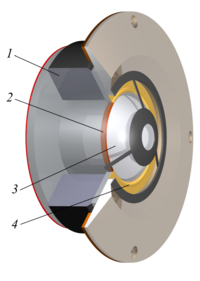
Photo from wikipedia
High-temperature blackbody radiation can provide the light source for broadband fiber sensing systems. To improve coupling efficiency, a coupling model of light intensity from the blackbody cavity into a cone-shaped… Click to show full abstract
High-temperature blackbody radiation can provide the light source for broadband fiber sensing systems. To improve coupling efficiency, a coupling model of light intensity from the blackbody cavity into a cone-shaped optical fiber was proposed. Influence of parameters of cone-shaped fiber and the blackbody cavity on coupling efficiency of light intensity were analyzed. Results show that coupling efficiency first decreases and then increases with the increase of the angle of cone-shaped fiber. When the angle of the cone is around 30°, coupling efficiency reaches the maximum. Cone-shaped fibers with angles around 8.8°, 19.4°, and 27.4° were fabricated by chemical etching. Experiments were carried out with cone-shaped fibers and a fiber with a flat end face. Results show that compared with the fiber with a flat end face, coupling efficiency of cone-shaped fiber with an angle around 8.8° is lower, cone-shaped fiber with an angle around 19.4° is almost the same, cone-shaped fiber with angle 27.4° is much stronger, and efficiency is improved by approximately 38%. The experimental results are consistent with the theoretical analysis.
Journal Title: Applied optics
Year Published: 2019
Link to full text (if available)
Share on Social Media: Sign Up to like & get
recommendations!